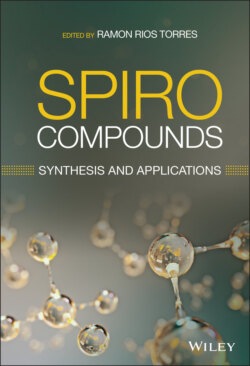Читать книгу Spiro Compounds - Группа авторов - Страница 30
3.3.4 Organocatalytic Miscellaneous Strategies to Construct Spiro Compounds
ОглавлениеThe group of Tu reported the enantioselective synthesis of spiro[4.4]nonane‐1,6‐diones 266, which represents the first direct example for the asymmetric synthesis of cyclopentanones using a Nazarov cyclization/semipinacol‐rearrangement sequence (Scheme 3.24) [36]. Substrate design revealed key for the successful development of the present strategy, where a cyclobutanol motif is connected to the α‐position of the cyclization precursor to induce the 1,2‐rearrangement. This tandem process is promoted by means of a chiral N‐triflylphosphoramide catalyst 268 to construct complex spirocompounds with four consecutive stereocenters in excellent stereocontrol (15 examples, 93 : 7–>99 : 1 dr, 84–97% ee). Computational calculations were performed to understand the reaction mechanism as well as the stereochemical outcome. The reaction begins with the formation of a hydrogen‐bond complex between the substrate and the catalyst. Then, the substrate is protonated by the catalyst and can be regarded as a pentadienyl cation, which then undergoes 4π‐conrotatory electrocyclization via TS1. The Nazarov reaction step is irreversible, since the transition state TS2 following the ring expansion event is much lower in energy. Then, the intermediate 269 undergoes a [1, 2] migration via TS2 to generate the intermediate 270 that is finally protonated to afford the spiranic product 266.
In other example of Bronsted acid catalysis, Tan and coworkers developed an enantioselective strategy for the construction of axially chiral compounds 277 (Scheme 3.25) [37]. This important class of spirocompounds is widely found in materials, organocatalysts, and ligands. The enantioselective intramolecular cyclization of ketals 278 to afford the SPINOL derivatives 277 is successfully catalyzed by the chiral phosphoric acid 279. Various ketals with different substitution patterns, including electron‐donating and electron‐withdrawing groups at the aryl ring, performed smoothly, affording the corresponding products 281–284 in high enantioselectivities and good to excellent yields (90−96% ee, 62−95% yield, conditions a). In the case of ketals bearing aromatic groups at the ortho position, the catalyst 280 (conditions b) was necessary to obtain the corresponding products. Remarkably, the catalytic system can be used at gram‐scale and the catalyst loading can be decreased as little as 0.1 mol%, despite higher temperature and prolonged reaction time are necessary.
Scheme 3.24 Organocatalytic asymmetric tandem Nazarov cyclization/semipinacol rearrangement.
Source: Modified from Yang et al. [36].
On the basis of mechanistic experiments, the authors propose that the reaction may initially form the intermediate 289, in situ generated from 288, which further proceed through the active o‐QM intermediate 290 to deliver the SPINOL derivative. The excellent stereocontrol was attributed to the simultaneous interaction between the bifunctional phosphoric acid and intermediate 291 via hydrogen‐bonding interactions.
Scheme 3.25 Chiral phosphoric acid‐catalyzed asymmetric synthesis of SPINOL derivatives.
Source: Modified from Li et al. [37].
